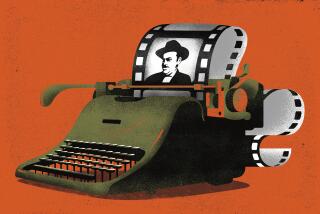An in-depth visit with Orson Welles
It was lost and now it’s found, and the world of Orson Welles enthusiasts, which very much includes me, counts itself grateful and amazed.
I am talking about 66 minutes of footage from an endeavor called “Too Much Johnson,” which Welles shot in 1938, three years before “Citizen Kane” changed everything. Not only had this material never been seen publicly, it had been presumed gone forever when the villa in Spain where Welles thought it was stored burned down nearly half a century ago.
Discovered in a warehouse in Pordenone, Italy, by local film society Cinemazero and beautifully restored via a collaboration between the George Eastman House in Rochester, N.Y., and the National Film Preservation Foundation, “Too Much Johnson” is ready for its Los Angeles close-up.
CRITICS’ PICKS: What to watch, where to go, what to eat
That will take place on May 3 in a program (including an appearance by actor and Welles collaborator Norman Lloyd) put on by the Academy of Motion Picture Arts and Sciences but taking place at LACMA’s Bing Theater.
“It’s the missing link in Welles’ work,” says Bernardo Rondeau, the academy’s director of programming, who shrewdly positioned the “Johnson” restoration as the opening wedge of a six-week series called “The Essential Orson Welles,” a rare chance to see a run of the master’s works in the best available versions that the academy will mount at LACMA. Screenings take place every Saturday through June 7.
Though the “Too Much Johnson” footage lasts 66 minutes, it is not a conventional feature film. To explain exactly what it is as well as to best understand its importance, a bit of context is necessary.
Welles’ first film was a six-minute short called “The Hearts of Age” (also part of the May 3 program) that he made in 1934 while he was still a teenager. His main creative output in his early 20s was the Mercury Theater, and for the 1938 season one of the plays he planned to put on was William Gillette’s 1894 farce “Too Much Johnson.”
Impatient with what he considered to be the play’s windy exposition, Welles had the idea of filming a trio of prologues in a slapstick style, one to go before each act, so that on stage he could, as he told author Peter Bogdanovich, “start right with the slamming doors.”
PHOTOS: Best films of 2013 | Kenneth Turan
Though the play project never came off, the 23-year-old Welles did shoot nearly four hours of footage, and the 66 minutes we have now is a lightly edited series of dailies from that shoot, the heart of which is a sequence featuring Joseph Cotton as a philanderer being chased through lower Manhattan by an outraged husband.
Because of the circumstances under which it was shot, the “Too Much Johnson” footage has no compelling plot and no soundtrack, though there will be live piano accompaniment on May 3. But watching it is an enormous pleasure three times over: We get to see the impressive amount of native ability Welles had, including shots that seem to prefigure his later work; we get to feel his palpable enthusiasm for this medium he was just beginning to seriously involve himself in; and we get to see a nimble Cotton dancing across the rooftops of New York like he was Burt Lancaster’s long-lost brother.
On the mind
Even putting “Too Much Johnson” aside, I’ve been thinking about Welles a lot recently because as the great genius of American directors he is never far from cineastes’ minds. For one thing, interesting new books about him are constantly coming out: “Orson Welles In Italy” by Alberto Anile and “Orson Welles and Roger Hill: A Friendship in Three Acts” by Todd Tarbox are but two recent examples.
More than that, I included two of the films the academy will be screening in “Not to Be Missed,” a forthcoming collection of essays I wrote about 54 of my favorite films.
A new digital version of 1958’s “Touch of Evil,” a spectacularly noirish police drama of crime and punishment, will screen on May 31 (along with a 35-millimeter print of “The Trial” from a private collection). And my other favorite Welles film, 1965’s “Chimes at Midnight,” also known as “Falstaff” for its portrayal of Shakespeare’s great rogue, will close the series on June 7 along with the intriguing “F for Fake.”
Repeated challenges
After Welles arrived in style with 1941’s magnificent “Kane,” for half a century the No. 1 film in Sight & Sound magazine’s once-a-decade greatest movies poll (and screening on May 10), the karmic balance the cinema gods apparently decreed meant nothing would ever be so easy for him again. Welles directed another dozen features, but each of them had its difficult, thorny aspects, either in terms of financing, distribution or control of final cut.
Critics argue ceaselessly over why someone so gifted faced so many hardships — was the problem Hollywood intransigence, Welles’ personality or some combination of the two? — but talking about him as a director is curiously equivalent to talking to baseball fans about the plight of the often-injured New York Yankee Mickey Mantle: How great could these men have been if they’d been able to operate at the peak of their powers?
Yet as far as the films Welles was able to complete are concerned, this is not as unremittingly bleak a story as it sounds. Even working under the variety of constraints and the daunting odds that became business as usual for him, Welles, congenitally incapable of ordinary work, was able to do some truly exceptional things.
PHOTOS: Box office top 10 of 2013
Though quite different in tone and sensibility, “Touch of Evil” and “Chimes at Midnight” are known for the way they star Welles in metaphysically — and literally — larger than life roles it’s difficult to imagine anyone else inhabiting.
Perhaps the most surprising thing about these efforts is the way they continue to surprise. No number of repeated viewings can dull the visual excitement Welles brought to all his work. Enjoy the previously unseen pleasures of “Too Much Johnson,” but don’t neglect to come back for the wonders that followed in its wake.
More to Read
Only good movies
Get the Indie Focus newsletter, Mark Olsen's weekly guide to the world of cinema.
You may occasionally receive promotional content from the Los Angeles Times.






